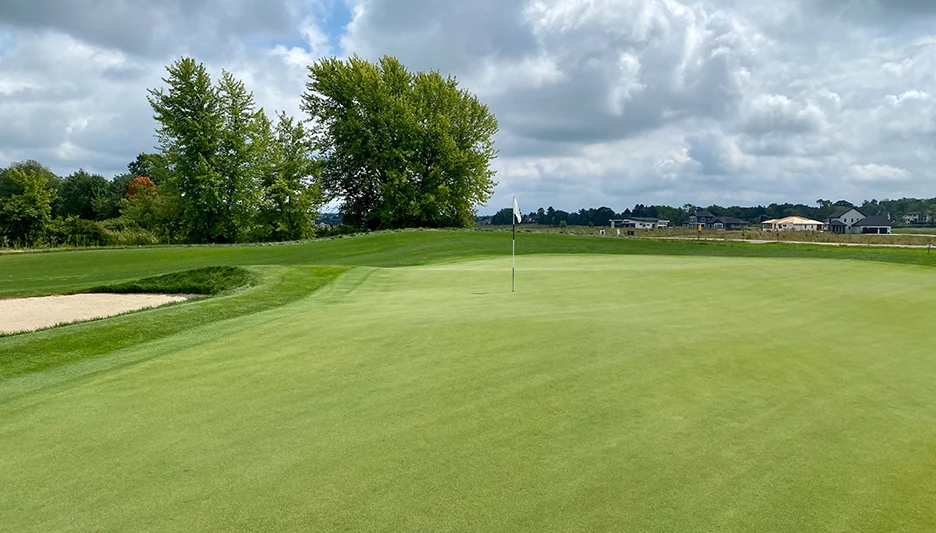
Guy Cipriano
From an agronomic and time-of-play perspective, Pioneer Pointe makes a compelling case as Wisconsin’s most novel new golf concept. Opened softly in late 2021 and fully in 2022, and surrounded by new homes, Pioneer Pointe is the only Upper Midwest course with bluegrass tees, fairways and approaches presented in a 13-hole short course package.
Good luck predicting how Pioneer Pointe fits into the golf marketplace.
A joyous whirl around the course late last summer with architect Todd Quitno and his son, Finn, and an 8-year-old wrestler who sparingly swings golf clubs (the author’s nephew Bowen), revealed father-son owners and developers Jeff Haen and Kyle Haen are experiencing major success selling lots around the course. Who doesn’t want to raise a family in Verona, Wisconsin, a desirable suburb in the thriving Madison metropolitan area?
Kyle and Jeff Haen also own nearby Hawk’s Landing Golf Club, which opened in 2001. The Haens employ the same superintendent to oversee the maintenance of both courses. Neil Radatz played a major role in the design, construction and grow-in of Hawk’s Landing and Pioneer Pointe. None of his peers has attempted to build and maintain a 13-hole course with bluegrass hitting surfaces.
Before getting to the brunt of the bluegrass part of the story, let’s explain in less than 13 seconds why Pioneer Pointe has 13 holes. Thirteen represents the lucky number of Wisconsin golf legend Jerry Kelly, who is Jeff Haen’s brother-in-law and Kyle Haen’s uncle. Kelly provided design input on transforming the former Tumbledown Trails Golf Course site into Pioneer Pointe.
About that bluegrass …
Observant golfers notice two things on the first tee: a yardage sign with a number and one height of dynamically striped turf leading to the green. Tees, fairways and approaches were mowed, at least in 2022 as Radatz learned the intricacies of the course, around half an inch. Observant golfers also notice Pioneer Pointe lacks tee markers. Drop a ball near the yardage sign, swing, hit and trot to the green.
Pioneer Pointe has 16 acres of tidy bluegrass. Radatz deliberated between bluegrass and bentgrass hitting surfaces. He selected bluegrass because of its potential for fast divot recovery. He went through the 2022 growing season without spraying a fungicide on the bluegrass despite an active dollar spot and summer patch season in the region. He also discovered bluegrass grows faster than he expected. Tradeoffs are part of building a new course.
“You can grow bentgrass here pretty easily and you can spray it for Poa annua,” Radatz says. “We know all those things. But there’s very little research with half-inch mowed bluegrass. There seems to be a lot of bluegrass fairways out in Colorado. But I don’t know anybody out there. Trying to figure out growth regulators and that kind of stuff has been challenging.”
Establishing a topdressing program has already helped promote one of Quitno’s design goals: creating shot options via bounce and roll without being overly severe or punitive to high-handicap or beginning golfers.
“It was important to me we were able to make the bluegrass work to feed the ball off the edges,” Quitno says. “Typically, in this climate, your shorter grass will be bentgrass, so you get those really firm approaches, roll off and on areas, extended collars, … whatever you want to call them. I was a little concerned that bluegrass wasn’t going to work as well to do that, but Neil has that so dialed in that it’s actually perfect.”
Maintaining bluegrass at a consistent height of cut like he did in 2022 means Radatz can maintain most of the course with just two mowers. Bentgrass covers the three acres of greens and tall fescue adds visual contrast to steep and dramatic bunker faces. A summer crew consisting of local high school students maintained bunker faces using fly mowers and string trimmers in Pioneer Pointe’s first full year of golf. Radatz is still determining how to maintain the faces in 2023 without overtaxing a young crew.
New courses take years to learn and Radatz remains as curious as he did in his early 20s, when he was “bouncing around between different jobs” and spotted a sign on Dorr Street in Toledo, Ohio, for famed Inverness Club. He pulled into the entrance and landed a position on superintendent Tom Walker’s crew. Walker sent Radatz to the middle of the course with a rake every day for a week. “I loved it,” Radatz says.
More than 30 years later, Radatz is poised to become a regional leader in maintaining bluegrass and bunker faces. The brown-sand, flat-bottomed surfaces were inspired by Charles Blair Macdonald and Seth Raynor, who executed some of their best work in the Midwest. Radatz didn’t want to settle for the easiest possible bunker complexes, so he encouraged Quitno and builder Golf Creations to push their design concepts. Pioneer Pointe draws inspiration from Golden Age par 3s most daily-fee players will never experience.
“We went through it and asked, ‘How do we build this thing?’” Radatz says. “My thought was, ‘We need to build it as good as it can possibly be. You plunk the best par 3s that anybody can play into the site.”
The site presented drainage and corridor conundrums for Quitno and his former design partner Bob Lohmann. Tumbledown Trails had a soggy history — “At one point we were walking through the old driving range and there was a rough mower completely stuck in the mud,” Quitno says — and fitting 13 holes into land that once supported 18 regulation holes proved tougher than expected.
The housing layout preceded the golf design, a swale intersected the property, and Dane County requires methodical permitting and environmental processes. Wetlands and native areas exist on the interior and periphery of the course. Golfers cross a street three times in the first five holes.
The course is flat until the sixth hole, a 116-yard uphill shot to a “Lion’s Mouth” green complex. Holes range from 103 to 264 yards, with design inspiration coming from ultra-private courses, including Shoreacres Golf Club, National Golf Links of America and nearby Blue Mound Country Club. The Golden Age flavor represents a tactic to attract customers from beyond the Madison area.
“It’s not an 18-hole course, so that might make it a tough draw,” Quitno says. “But if there’s some dynamic architecture and it’s really interesting to play, somebody will want to play it a couple times when they are here. It had to be high-end, well-done holes.”
Come for the design. Stay for the bounces and bluegrass.
The 8-year-old is begging to return after wrestling season. And a veteran superintendent is anxious for the bluegrass to thaw.
“I absolutely love being here,” Radatz says. “It’s so different. I will come here, look around and see what’s going on, and I know once we start putting some more sand down around these greens, balls are going to really start bouncing.”

Explore the January 2023 Issue
Check out more from this issue and find your next story to read.
Latest from Golf Course Industry
- From the publisher’s pen: Conscientious of a bigger role
- Bernhard and Company partners with Laguna Golf Phuket
- Terre Blanche showcases environmental stewardship
- VIDEO: Introducing our December issue
- Bernhard and Company introduces Soil Scout
- Nu-Pipe donates to GCSAA Foundation’s Centennial Campaign
- GCSAA enhances golf course BMP tool
- Melrose leadership programs sending 18 to 2026 GCSAA Conference and Trade Show





